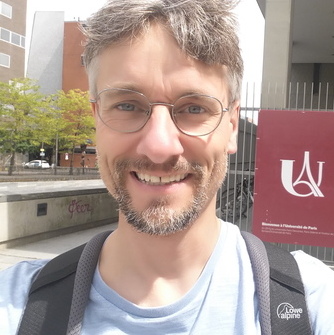–
Room P3.10, Mathematics Building

TQFT approach to meromorphic connections II
The moduli space of flat $C^\infty$ connections on rank $n$ vector bundles on a smooth complex algebraic curve $\Sigma$ has an explicit description as the space of representations of the fundamental group: $${\mathcal M}_B = {\rm Hom}(\pi_1(\Sigma),G)/G,\qquad G={\rm GL}_n({\mathbb C})$$ often called the character variety (or Betti moduli space). It has an algebraic Poisson structure with symplectic leaves ${\mathcal M}_B({\bf{\mathcal C}})\subset {\mathcal M}_B$ given by fixing the conjugacy classes of monodromy around each puncture. Choosing suitable generators of $\pi_1(\Sigma)$ this becomes the quotient by $G$ of a space of matrices satisfying a relation of the form $$[A_1,B_1]\cdots[A_g,B_g]M_1\cdots M_m=1$$ where $[a,b]=aba^{-1}b^{-1}$. Thus ${\mathcal M}_B$ “looks like” a multiplicative version of a symplectic (Marsden-Weinstein) quotient, with $G$-valued moment map $\mu$ given by the left-hand side of the relation, so that ${\mathcal M}_B=\mu^{-1}(1)/G$. This “quasi-Hamiltonian” theory was set-up by Alekseev-Malkin-Meinrenken, and leads to the construction of the symplectic manifolds ${\mathcal M}_B({\bf \mathcal C})$ as the multiplicative symplectic quotient of the fusion product of two basic types pieces (conjugacy classes ${\mathcal C}$ and doubles ${\rm \bf D}$).
However this story is just the tip of the iceberg: In algebraic geometry the space ${\mathcal M}_B$ just parametrises the special class of algebraic connections on rank $n$ algebraic vector bundles on $\Sigma$ with tame/regular singular behaviour at the punctures. In this course I’ll first review the topological description of the full category of algebraic connections in terms of Stokes local systems, and the resulting explicit presentations of the wild character varieties (many of which go back to Birkhoff 1913). In turn I’ll describe the extension of the above story, constructing the wild character varieties as algebraic symplectic/Poisson varieties, by fusing together and reducing some new basic pieces (the fission spaces ${\mathcal A}$ and ${\mathcal B}$).
If time permits I'll discuss other topics such as
- the fact the Drinfeld-Jimbo quantum group quantises a quite simple wild character variety,
- the notion of wild Riemann surface and the resulting wild mapping group action on the wild character varieties,
- the upgrading of the symplectic structure to a hyperkahler structure, yielding the link to meromorphic Higgs bundles,
- the quasi-Hamiltonian fusion approach to complex WKB.
Some references/sources:
Quasi-Hamiltonian geometry (for compact Lie groups) was defined in:
- Alekseev, Malkin, Meinrenken, Lie group valued moment maps, math.DG/9707021
and the extension of this formalism to complex groups that we use is in:
- Alekseev, Bursztyn, Meinrenken, Pure spinors on Lie groups, arXiv:0709.1452
The wild extension is in the sequence of papers:
- Quasi-Hamiltonian Geometry of Meromorphic Connections, arXiv:math/0203161, published in Duke 2007 [[the generic case, for any reductive group $G$]].
- Through the analytic halo: Fission via irregular singularities, arXiv:1305.6465, Ann. Inst. Fourier 59, 7 (2009) 2669-2684 [[the simplest non-generic case]
- Geometry and braiding of Stokes data; Fission and wild character varieties, Annals of Math. 179 (2014) 301-365 (arXiv:1111.6228) [[the general untwisted case]]
- P.Boalch and D. Yamakawa, Twisted wild character varieties, arXiv:1512.08091 [[the general case]]
An earlier analytic approach to these symplectic manifolds is in P.Boalch, Symplectic Manifolds and Isomonodromic Deformations, Adv. in Math. 163 (2001) 137-205, and the hyperkahler upgrade is in:
- P. Boalch and O. Biquard, Wild non-abelian Hodge theory on curves, Compos. Math. 140 (2004) no. 1, 179-204
A “simple as possible” description of several intrinsic approaches to Stokes data for general linear groups is in
- arXiv:1903.12612 (Topology of the Stokes phenomenon).
The introduction of this paper aims to give a good guide to the Stokes data literature.
Several explicit descriptions of some of the simplest examples is in arXiv:1501.00930 (Wild Character Varieties, points on the Riemann sphere and Calabi's examples), and reviews of several different directions related to this story are in arXiv:1305.6593, arXiv:1703.10376.
Funded under FCT projects UIDB/MAT/04459/2020 and PTDC/MAT-PUR/30234/2017.